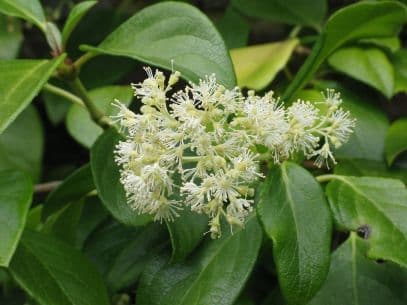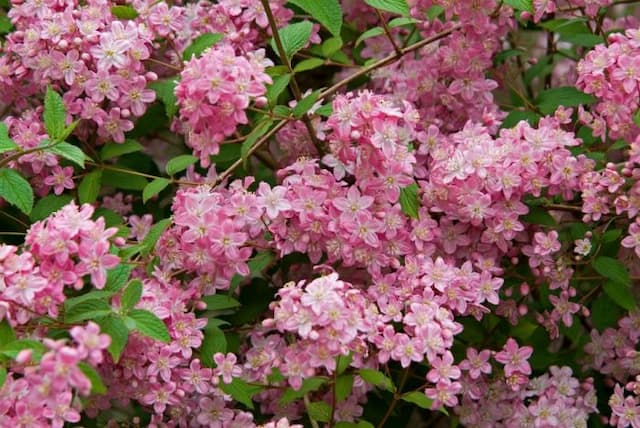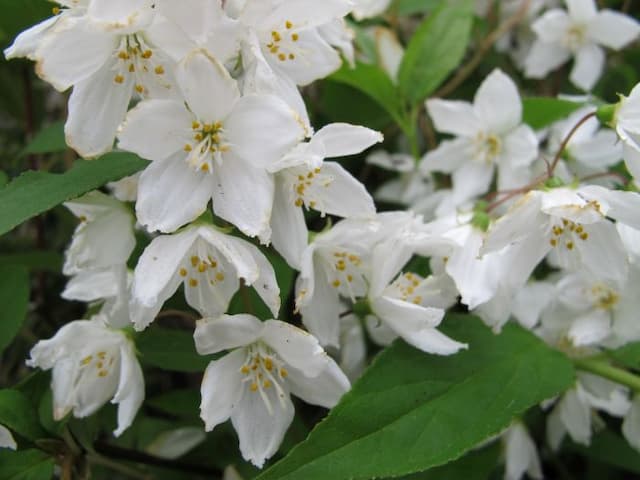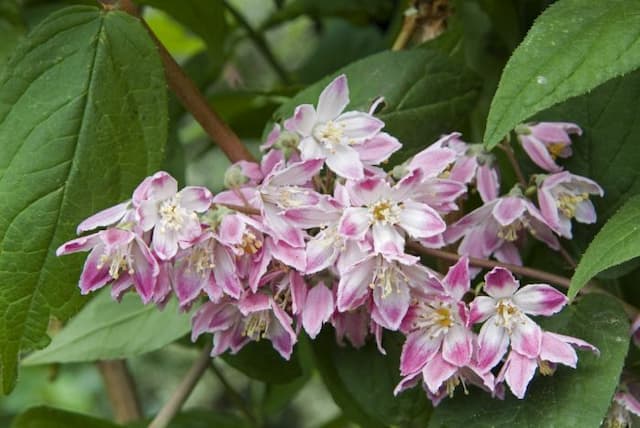Bluebird Hydrangea Hydrangea serrata 'Santiago' (PBR) (L)

ABOUT
The Hydrangea serrata 'Santiago' is a captivating plant that features a bushy and rounded habit, bursting with lush green foliage. This variety of hydrangea showcases pointed, oval leaves that carry a deep green hue, creating a rich backdrop for the plant's standout feature: its flowers. The blooms are truly arresting, displaying a double flowering effect. Each flower head is a rounded cluster, known as a corymb, composed of numerous individual florets, and these blooms possess a remarkable feature—they can change color. The hue transitions from soft pink to a delicate blue, dependent on the soil's acidity. Those grown in more acidic soils take on a bluer tone, while alkaline conditions result in pinker flowers. These color-changing abilities add a dynamic and interactive element to the garden. The blooms are not only a visual delight but also last for a considerable duration, extending the ornamental appeal of the plant through its blooming season. Additionally, the plant is adorned with faded flowers in attractive shades of cream and green, which persist and add further interest even after the peak flowering period has passed. Overall, Hydrangea serrata 'Santiago' is a plant with a striking presence, due in large part to its vibrant foliage and the enchanting, color-changing blooms that so define its appearance.
About this plant
 Names
NamesFamily
Hydrangeaceae.
Synonyms
Mountain Hydrangea, Tea of Heaven, Sawtooth Hydrangea.
Common names
Hydrangea serrata 'Santiago' (PBR) (L)
 Toxicity
ToxicityTo humans
The common name for Hydrangea serrata 'Santiago' is mountain hydrangea. Mountain hydrangeas contain a compound called hydrangin, which can be toxic if ingested. However, poisoning from hydrangeas is rare. If large quantities of the plant, particularly the leaves and flowers, are consumed, they may cause gastrointestinal upset, with symptoms such as nausea, vomiting, and diarrhea. In more severe cases, ingestion can lead to depression, lethargy, and confusion. It is advisable to keep any part of this plant out of the reach of children to prevent accidental ingestion.
To pets
Mountain hydrangea can be toxic to pets if ingested. The plant contains compounds such as cyanogenic glycosides, which can release cyanide when chewed or digested. Symptoms of toxicity in pets may include vomiting, diarrhea, depression, and in severe cases, could potentially lead to more serious symptoms such as difficulty breathing or seizures. As pets, particularly dogs and cats, can be more likely to chew on plants, it's important for pet owners to ensure these plants are kept out of reach to prevent accidental poisoning.
 Characteristics
CharacteristicsLife cycle
Perennials
Foliage type
Deciduous
Color of leaves
Green
Flower color
Varies
Height
2-4 feet (60-120 cm)
Spread
2-4 feet (60-120 cm)
Plant type
Shrub
Hardiness zones
6
Native area
Asia
Benefits
 General Benefits
General Benefits- Aesthetic Appeal: Hydrangea serrata 'Santiago' provides ornamental value with its beautiful lacecap flowers that can range in color from blue to pink depending on the soil pH.
- Seasonal Interest: The plant offers visual interest throughout the growing season, with flowers blooming from early summer to fall.
- Garden Versatility: This hydrangea is suitable for a variety of garden settings, including borders, foundation plantings, and as a specimen plant.
- Attracts Pollinators: The flowers attract bees and other pollinators, supporting biodiversity in the garden.
- Compact Size: Being a compact shrub, it is especially suitable for smaller gardens or limited spaces.
- Shade Tolerance: It is capable of growing well in partial shade, providing options for gardeners with less sunny landscapes.
- Easy Propagation: Hydrangea serrata 'Santiago' can be easily propagated from cuttings, making it easy for gardeners to create new plants.
- Easy Pruning: Pruning is generally simple as it blooms on old wood, requiring minimal maintenance to keep the plant healthy and well-shaped.
 Medical Properties
Medical Properties- Hydrangea serrata, commonly known as mountain hydrangea, has been traditionally used in folk medicine for its diuretic and lithotripic (helping to dissolve kidney stones) properties.
- The plant may possess anti-malarial qualities due to the presence of certain active compounds, although more research is needed to confirm this potential use.
- Some cultures have used mountain hydrangea for its possible anti-inflammatory effects to treat conditions such as arthritis and prostate issues, but scientific backing for such uses is limited.
- The roots of mountain hydrangea have been employed in herbal medicine for their potential effect on urinary tract issues such as infections and bladder stones, though these uses lack rigorous clinical studies.
- There is historical use of mountain hydrangea for managing blood sugar levels, although this is not supported by contemporary scientific studies and should not be taken as medical advice.
 Air-purifying Qualities
Air-purifying QualitiesThis plant is not specifically known for air purifying qualities.
 Other Uses
Other Uses- Hydrangea serrata 'Santiago' leaves can be used to create a natural green dye for fabrics or paper, which is often explored in artisanal crafts and eco-friendly production methods.
- The dried flowers of the Hydrangea can be used in potpourris to impart a subtle fragrance and add a touch of color to the mixture.
- Wood from mature Hydrangea shrubs can be carved into small decorative items or utilized in marquetry, given its fine grain when properly treated.
- Hydrangea flowers can serve as a pH indicator in educational science experiments, as the color of the blooms can indicate the acidity or alkalinity of a solution.
- The bark and branches of the Hydrangea can be used in small-scale basket weaving or as a natural component in wreath-making due to their flexibility when young.
- In photography and cinematography, the blooms can be employed for set decoration to create particular aesthetics or evoke certain seasons.
- Pressed Hydrangea flowers are often used in homemade paper making for a decorative touch, imparting their silhouettes and hues within the paper sheets.
- Hydrangea flowers are sometimes frozen into ice cubes to add an elegant, floral touch to drinks for special events and occasions.
- The shrub's dense foliage can be maintained as a natural privacy screen or a noise buffer in urban gardens.
- Artists may use the range of colors found in Hydrangea blossoms as a palette for painting or as inspiration for color schemes in visual art.
Interesting Facts
 Feng Shui
Feng ShuiThe plant Hydrangea is not used in Feng Shui practice.
 Zodiac Sign Compitability
Zodiac Sign CompitabilityThe plant Hydrangea is not used in astrology practice.
 Plant Symbolism
Plant Symbolism- Heartfelt Emotions: Hydrangea serrata, commonly known as mountain hydrangea, often symbolizes deep and heartfelt emotions due to its abundant and lush blooms.
- Gratitude: Mountain hydrangea is associated with expressions of gratitude, making the flowers a popular gift to express thanks.
- Apology: In some contexts, the hydrangea can represent an apology or a request for forgiveness, possibly due to the plant's ability to change color based on soil pH, which can be seen as emblematic of change or transformation.
- Vanity or Frivolity: Historically, in certain cultures, the mountain hydrangea has been associated with vanity and superficiality because of its showy, ornate blossoms.
- Understanding: The plant is also sometimes a symbol of understanding and comprehension, perhaps attributed to its dense, multi-flowered appearance, suggesting a fullness of insight.
 Water
WaterFor the Mountain Hydrangea, it should be watered deeply once a week, ensuring the soil is moist but not soggy. During hot or dry periods, watering frequency should be increased to twice a week, providing about one gallon of water per plant. A slow, steady trickle of water is best to allow deep penetration into the root system without causing runoff. In the winter, reduce watering but do not let the soil completely dry out. Adjust the schedule to account for rainfall and avoid waterlogging.
 Light
LightThe Mountain Hydrangea thrives in partial shade to filtered sunlight. It should be placed in a location where it receives morning sunlight and is protected from the harsh afternoon sun. Dappled sunlight under the canopy of larger trees is ideal for this plant to flourish without experiencing leaf scorch.
 Temperature
TemperatureThe Mountain Hydrangea prefers a temperature range of 60°F to 75°F for optimal growth. It can tolerate minimum temperatures down to around 50°F but should be protected from frost. Avoid exposure to temperatures over 80°F as it can stress the plant and impede its development.
 Pruning
PruningPrune the Mountain Hydrangea after it blooms to remove spent flowers and encourage new growth. Light pruning can be done to shape the plant in late winter or early spring before new growth begins. It is generally recommended to remove no more than one-third of the plant to maintain its health and fullness.
 Cleaning
CleaningAs needed
 Soil
SoilMountain Hydrangea prefers well-draining, moist soil rich in organic matter. Aim for a soil pH of 5.5 to 6.5 to maintain vibrant foliage and flower color.
 Repotting
RepottingMountain Hydrangeas should be repotted every 2 to 3 years or when they outgrow their current container.
 Humidity & Misting
Humidity & MistingMountain Hydrangea thrives at high humidity levels, above 60% if possible, to mimic its natural environment.
 Suitable locations
Suitable locationsIndoor
Place in bright, indirect light and keep soil moist.
Outdoor
Plant in partial shade and shelter from strong winds.
Hardiness zone
6-9 USDA
 Life cycle
Life cycleHydrangea serrata 'Santiago', commonly known as Bluebird Lacecap Hydrangea, begins its life cycle as a dormant seed that requires stratification before germination. After stratification, the seed germinates in spring, developing into a seedling with a basic root system and foliage. As the plant matures, it enters a vegetative stage, producing larger leaves, stems, and a more extensive root network. Once it reaches maturity, typically within a few years, it enters the reproductive stage, producing distinctive lacecap flowers with both small fertile florets and larger sterile florets which can be blue, pink, or purple depending on soil pH. After pollination and fertilization, the plant produces seed capsules that, upon maturation, release seeds to complete the cycle. Bluebird Lacecap Hydrangea enters a period of dormancy during the colder months, conserving energy to begin the cycle anew in the following spring.
 Propogation
PropogationPropogation time
Spring to Summer
The most popular method of propagating Hydrangea serrata 'Santiago', often referred to as Mountain Hydrangea, is through softwood cuttings. This process typically takes place in late spring to early summer when the plant's new growth is still tender and green. Cuttings should be about 5 to 6 inches long with several sets of leaves. The lower leaves are removed and the cut end is dipped in rooting hormone to encourage root development. These prepared cuttings are then inserted into a moist potting mix and placed in a well-lit area with high humidity, but out of direct sunlight. Ensuring the medium stays consistently moist but not waterlogged is crucial for the successful rooting, which may take several weeks to occur. After roots have developed, cuttings can be transplanted into individual pots to grow on before being planted out into their final location.






![Rose deutzia [Yuki Cherry Blossom]](/_next/image?url=https%3A%2F%2Fplants-admin.emdemapps.com%2Fimages%2Fplants%2F%2Fimages%2F604b6510a383a.png&w=640&q=75)

![Hydrangea [Hot Chocolate]](/_next/image?url=https%3A%2F%2Fplants-admin.emdemapps.com%2Fimages%2Fplants%2F%2Fimages%2F604b5a066e3bd.png&w=640&q=75)
![Hydrangea [Blackberry Pie]](/_next/image?url=https%3A%2F%2Fplants-admin.emdemapps.com%2Fimages%2Fplants%2F%2Fimages%2F604b56e2abc1d.png&w=640&q=75)